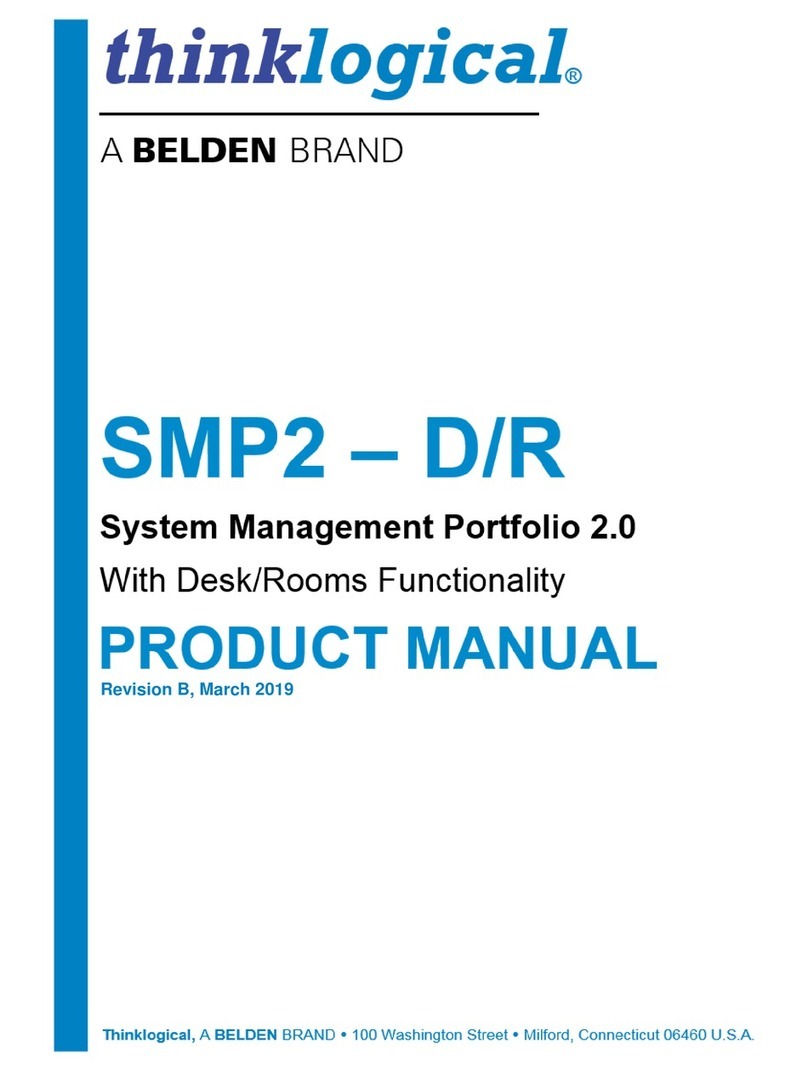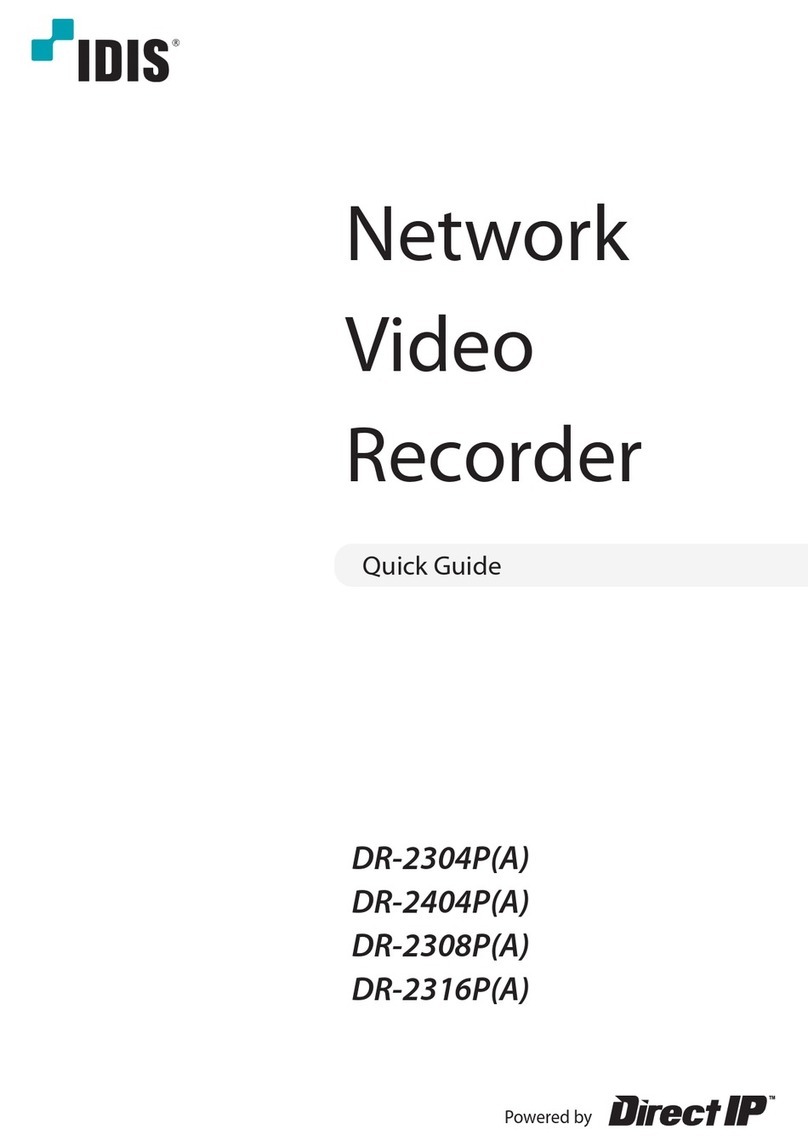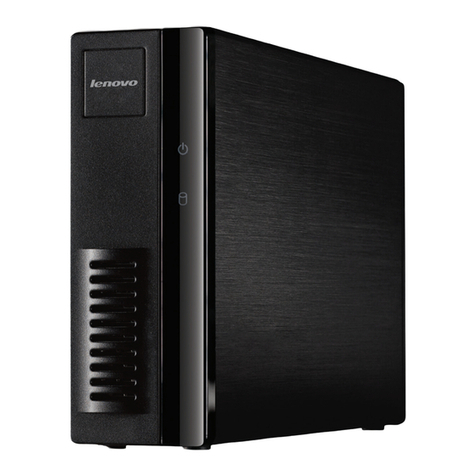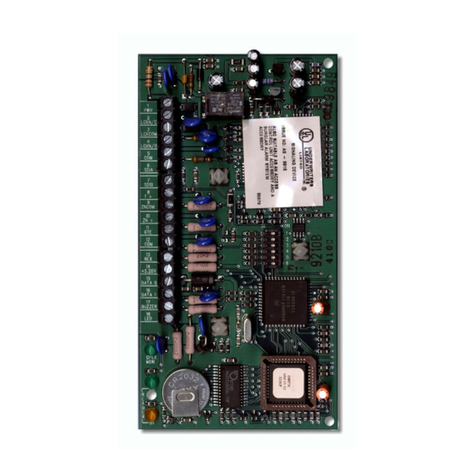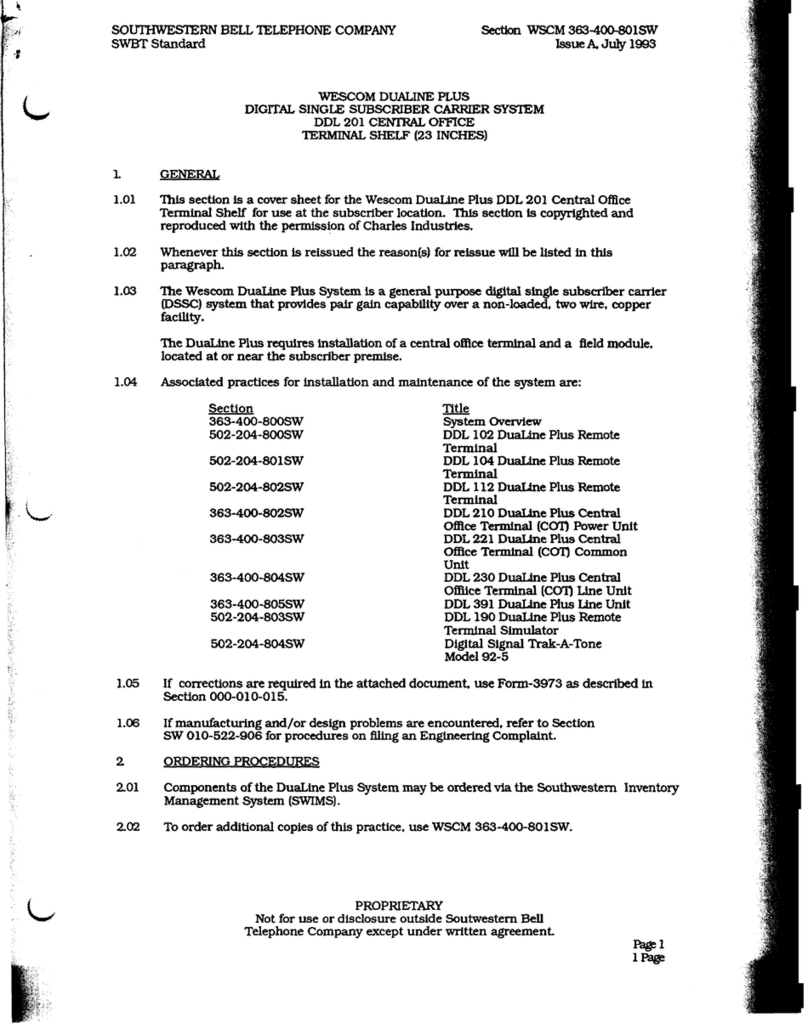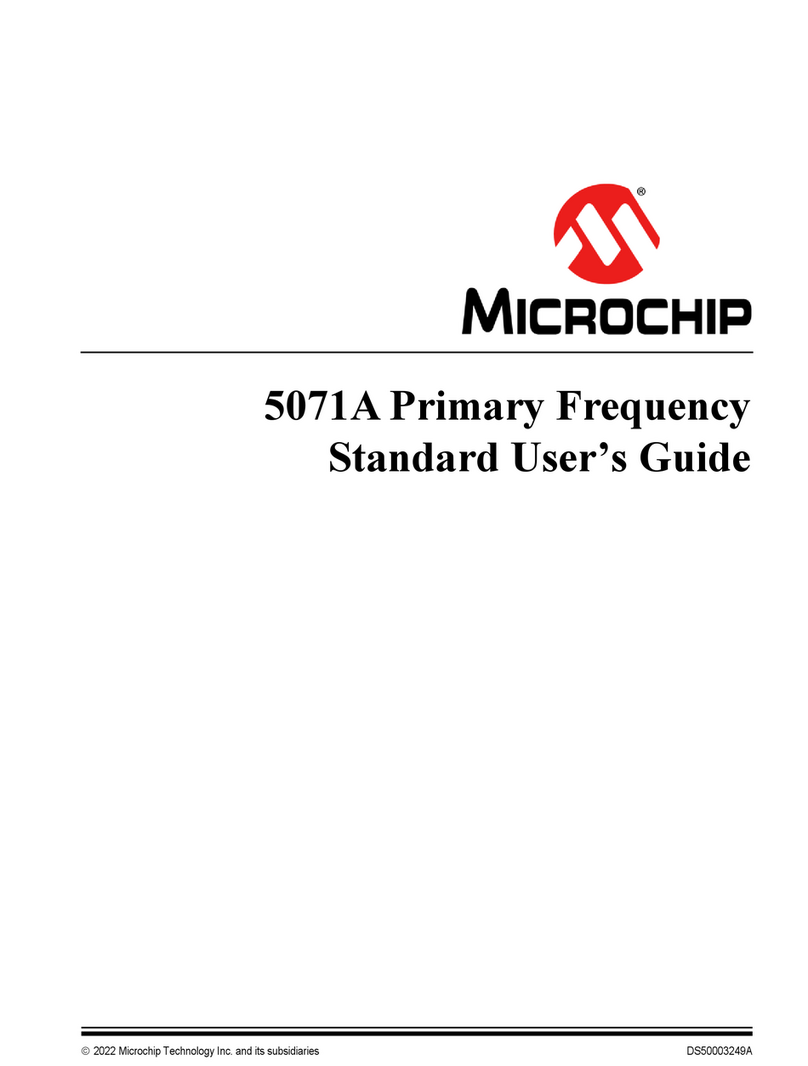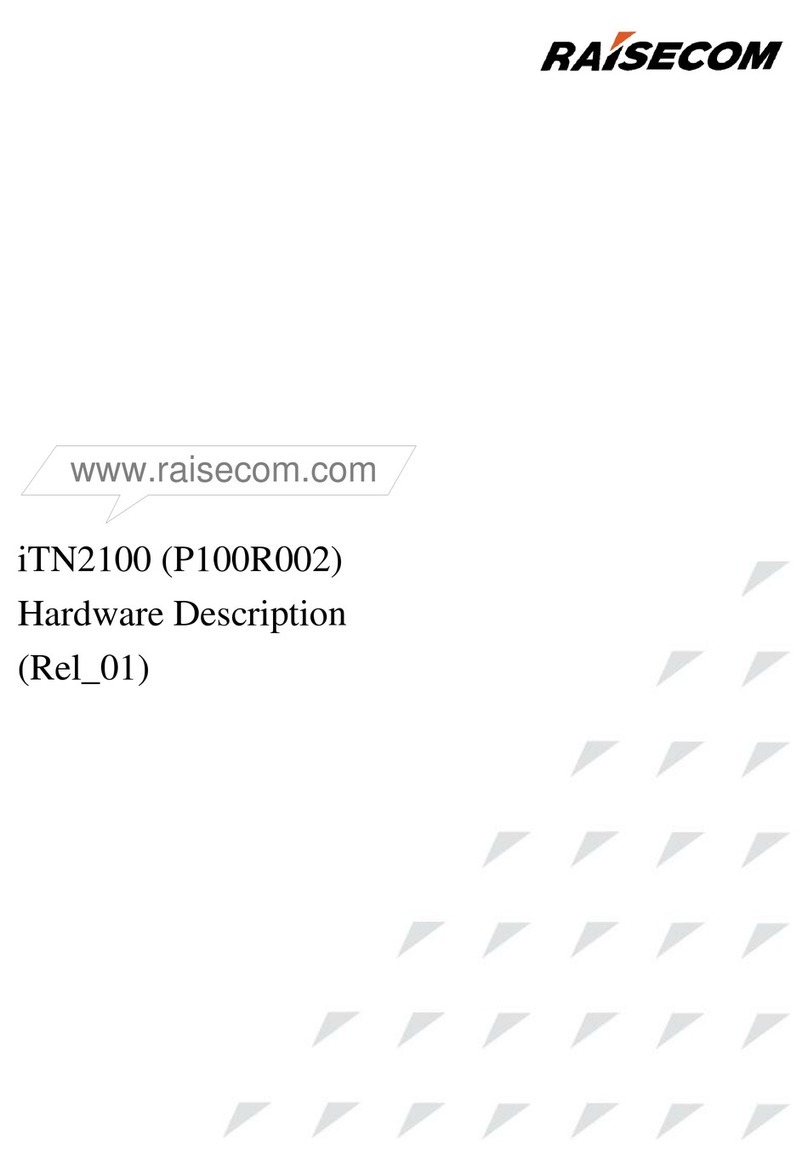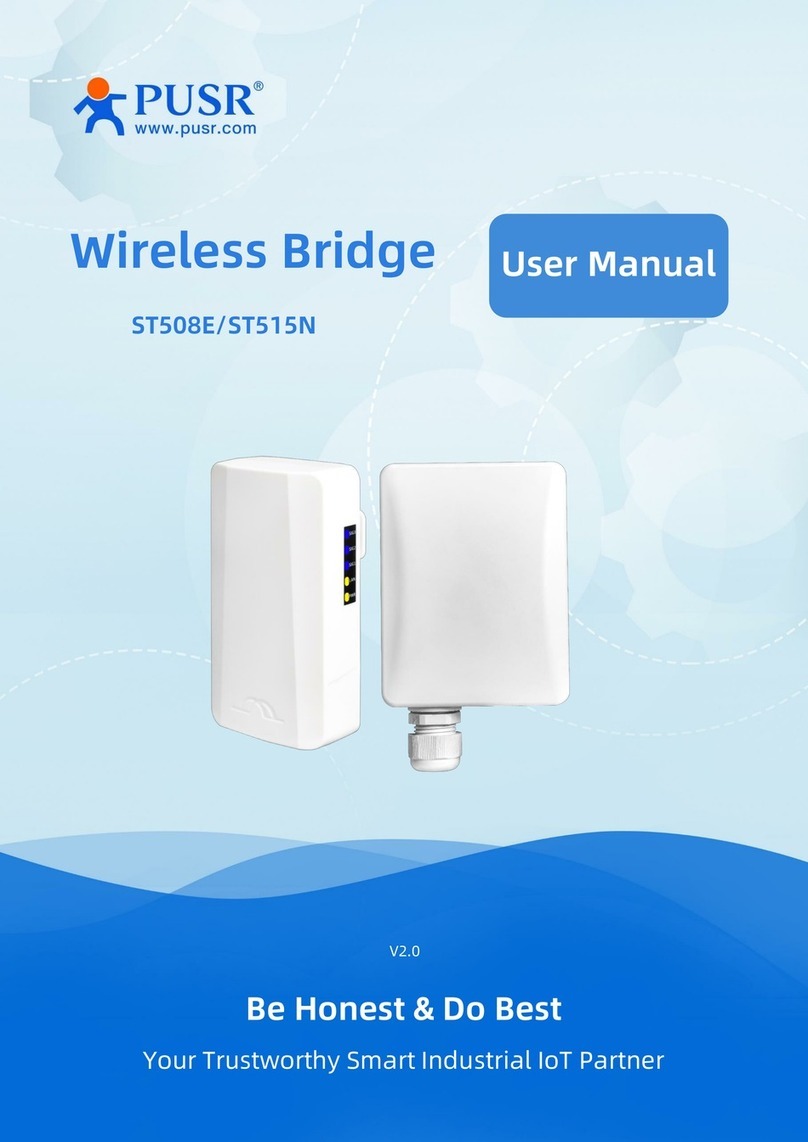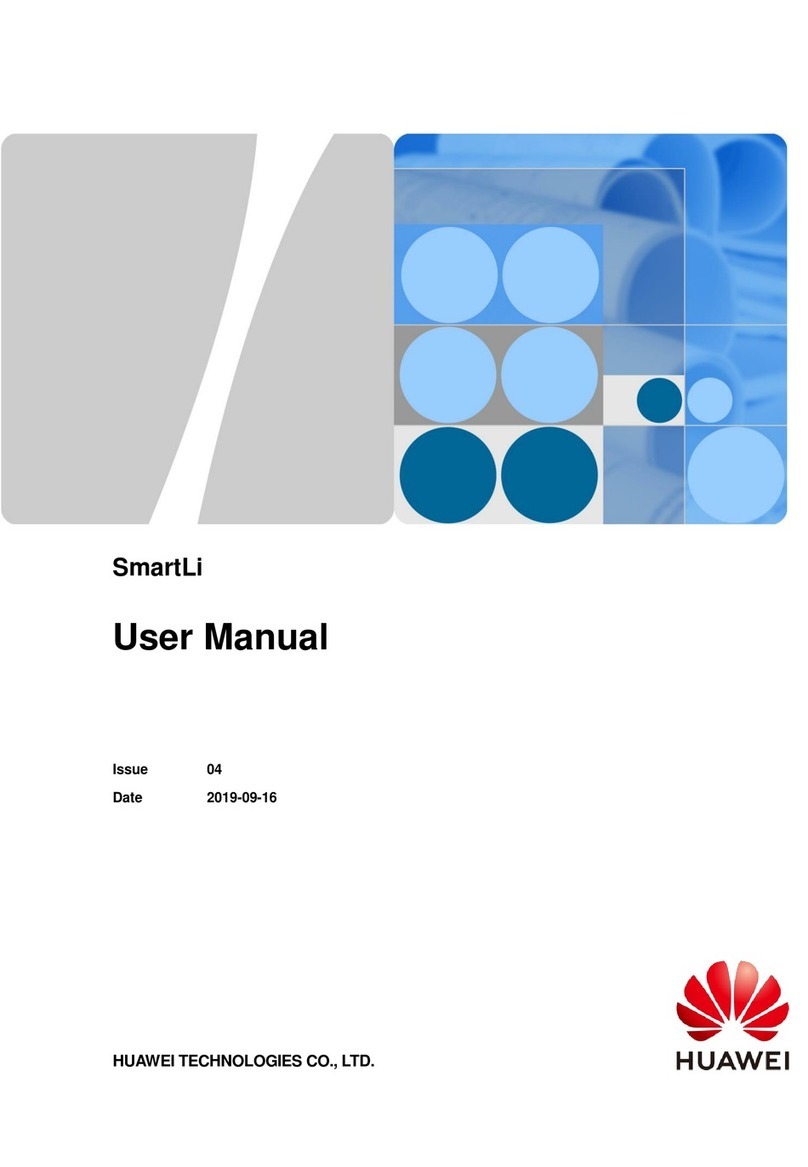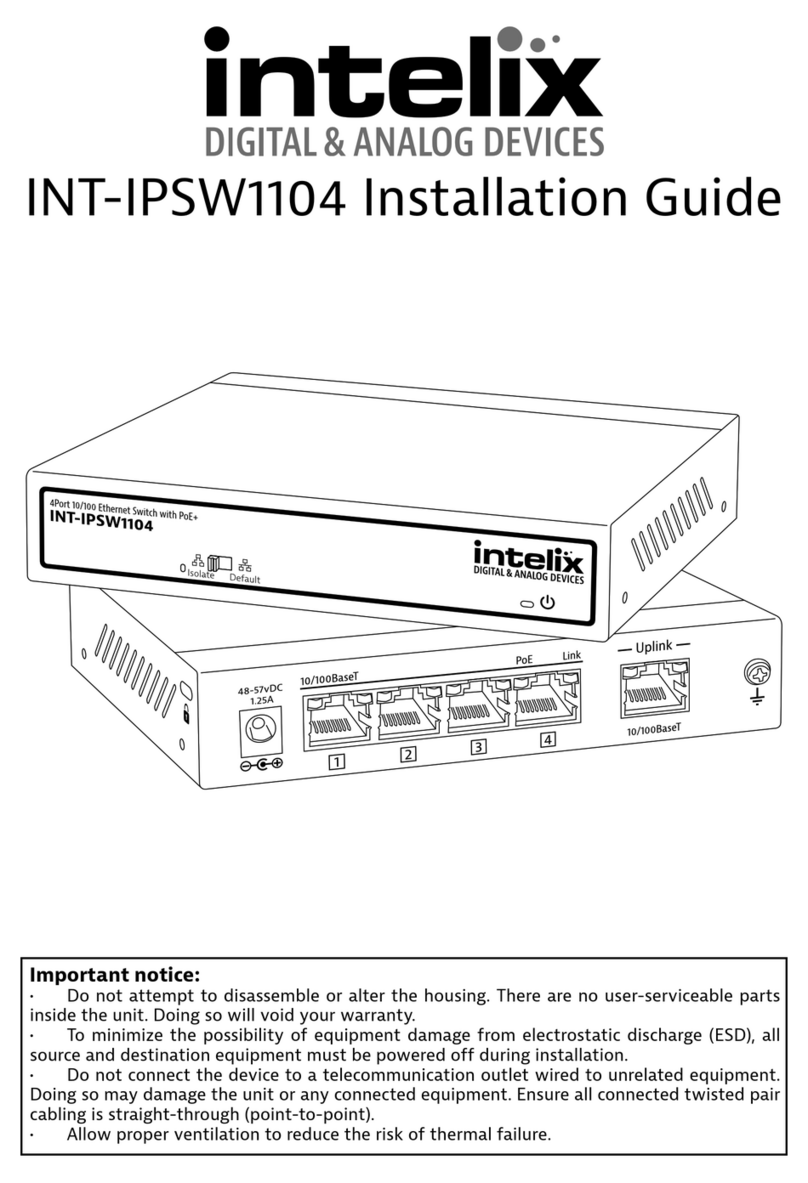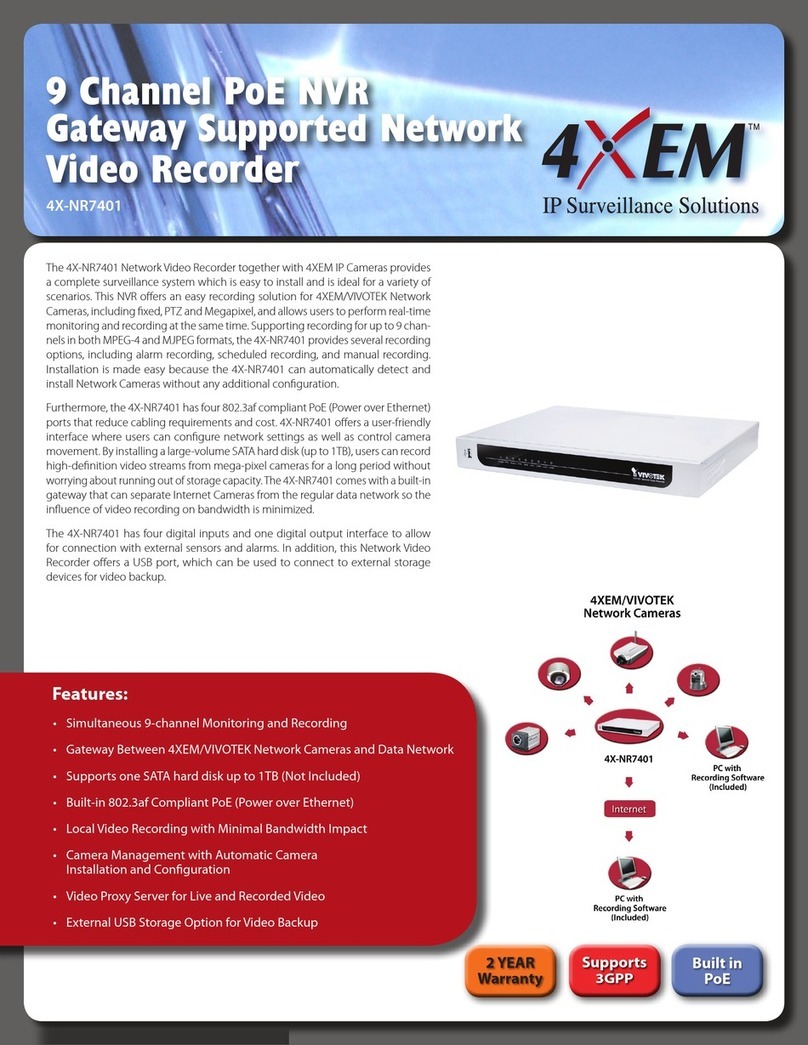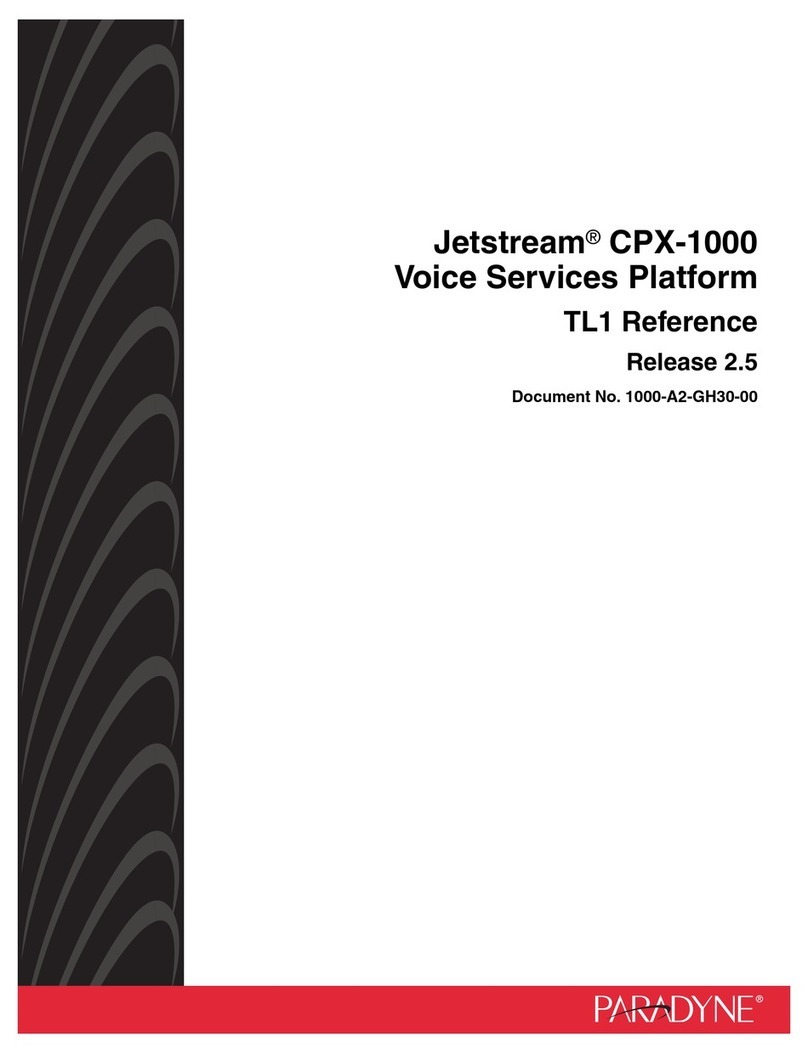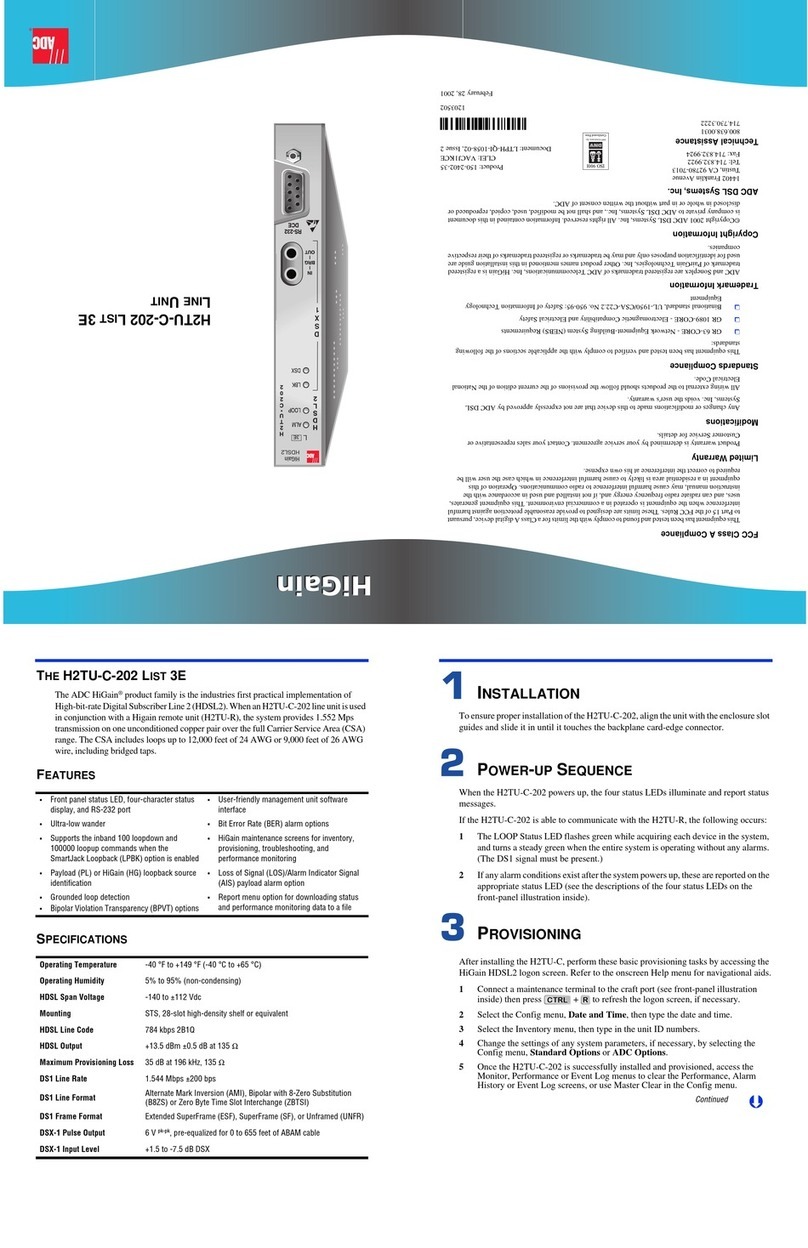Myricom Myrinet-2000 User manual

© 2001, Myricom, Inc. -- 1 -- Revision: 27 August 2001
Guide to Myrinet-2000
Switches and Switch Networks
Myricom, Inc.
Revision: 27 August 2001
Safety, Installation, and Use Precautions
Provide power to the switch enclosures only with a 3-wire, IEC line cord from an outlet that
includes a safety ground. The input power is 100–127 V~ or 200–240 V~, 50Hz or 60Hz. All
switch enclosures are shipped with a power cord appropriate to the unit and to the shipping
destination. The power cord should be rated for 10A except for 100–127V~ power cords for the
M3-E128, which are rated for 15A.
An M3-E128 switch enclosure fully populated with line cards weighs approximately 31 kg (68
pounds). Two people are required to mount this unit in a rack. One person should not attempt to
install an M3-E128 switch unit in a rack. The rack mounting holes conform to the EIA-310
standard for 19-inch racks.
Line cards and the fan tray may be “hot swapped” (inserted or removed with the power on).
However,
•Insert and remove line cards gently, according to the instructions that start on page 4.
•Do not operate a switch for extended periods with missing line cards. Use M3-BLANK
panels to fill in any empty line-card slots. The front of the enclosure needs to be closed
both for the efficiency of the fan cooling and to avoid electromagnetic interference
(EMI).
•Each line card includes thermal sensors. Operating the switch without a fan tray for more
than one minute may result in line cards turning themselves off.
Configurations with optical-fiber Myrinet ports are Class I Laser Products. Optical-fiber
components with this classification pose no threat of biological damage.
The most recent revision of this document can be downloaded from
http://www.myri.com/myrinet/m3switch/guide/ ,
and supplemental information is linked from this same web page.

© 2001, Myricom, Inc. -- 2 -- Revision: 27 August 2001
Safety and EMC Certifications
This device complies with Part 15 of FCC Rules and all Class A
requirements for digital apparatus of the Canadian Interference
Causing Equipment Regulations. Operation is subject to the following
two conditions: (1) this device may not cause harmful interference,
and (2) this device must accept any interference received, including
interference that may cause undesired operation.
Made in U.S.A.
from domestic
and foreign
components
Myrinet M3-E32
A label similar to that above appears on the back of M3-E16, M3-E32, M3-E64, and M3-E128
switch enclosures shipped after the corresponding certifications were received.
Safety. Myricom is proud to employ TUV Rheinland of North America, Inc., to perform the
independent safety certifications for these Myrinet-2000 switch products. The M3-E16, M3-
E32, M3-E64, and M3-E128 were certified in accordance with the IEC System for Conformity
Testing and Certification of Electrical Equipment (IECEE), CB Scheme. In addition, TUV
certified these products to the US and Canadian safety standards.
Electromagnetic Compatibility (EMC). Subject to the limitations listed below, Myrinet-
2000 switch products based on the M3-E16, M3-E32, M3-E64, and M3-E128 are within Class A
limits for emission of and susceptibility to electromagnetic interference (EMI).
•An M3-BLANK filler panel must be used in any line-card slot without a line card.
•The M3-E16 may use any combination of M3-M, M3-SW16-8F, M3-SPINE-8F, M3-
SW16-8S, M3-SPINE-8S, or M3-SW12-4L line cards.
•The M3-E32, M3-E64, and M3-E128 may use any combination of M3-M, M3-SW16-8F,
or M3-SPINE-8F line cards.
EMI certification of additional configurations of line cards is in progress as of the date of this
revision. As additional EMI certifications are completed, they will be added to this document.

© 2001, Myricom, Inc. -- 3 -- Revision: 27 August 2001
Characteristics and Installation of Myrinet Cables
Although all Myrinet links carry packets in the same format at the Data Link level, Myrinet has
five different Physical level (PHY) implementations over four different types of cables. It is
important to understand the characteristics of the types of cables used at your site, and how to
install them. All Myrinet cables may be plugged or unplugged with the component power on.
Fiber is the preferred Myrinet PHY for several reasons:
•The fiber cables are small, light, flexible, and easy to install.
•The fiber cables and connectors exhibit exceptionally high reliability.
•Myrinet-Fiber cables may be up to 200m in length.
•Myrinet-Fiber components and cables operate within Class A limits for the emission of
electromagnetic interference (EMI).
Myrinet-Fiber links carry packet data at a 2+2 Gb/s data rate on industry-standard 50/125
multimode-fiber-pair cables with “LC” connectorization. Myricom ships Fiber components with
a dust plug in each port. It is recommended that the dust plug be left in place in unused switch
ports. The fiber cable is shipped with dust caps on the ends of the fibers. To install the fiber
cable, just remove the dust plug and dust caps, and insert the fiber-end connector.
Press the locking tab on the LC cable-end connector to remove the fiber cable.
Dust Plug
Press tab
to remove cable

© 2001, Myricom, Inc. -- 4 -- Revision: 27 August 2001
Serial links carry Myrinet packet data at a 2+2 Gb/s data rate on industry-standard HSSDC
(High-Speed Serial Data Connector) cables up to 10m in length. These shielded cables are
certified in several small configurations to Class A limits for the emission of EMI1. Myricom
supplies HSSDC cables from manufacturers whose cables we have qualified through extensive
testing. Not all HSSDC cables will function properly as Myrinet Serial cables.
The HSSDC cable-end connector snaps into a Serial port. Please observe the locking tab on the
cable-end connector:
In order to remove a cable, it is very important to depress the locking tab. Otherwise, the port
connector will be damaged.
SAN (System Area Network) links are carried on unshielded “microstrip” ribbon cables up to
3m in length. In fact, a single cable carries two links, designated as
the “A” and “B” links, and the same cables are used for two different
Myrinet PHYs, SAN-1280 (1.28+1.28 Gb/s) and SAN-2000 (2.0+2.0
Gb/s). As you can see from the photo to the left, SAN cable-end
connectors include a locking mechanism. These locking springs
should both be depressed when inserting and when removing a SAN
cable-end connector.
SAN links are for “in-cabinet” applications only. Switch configurations with any SAN line
cards (M3-SW16-8M or M3-SW16-4DM) exceed Class A limits for EMI, and should be used
only within a shielding enclosure. Also, it is best to restrict the use of SAN cables to within an
enclosure because they will withstand only moderate physical abuse.
LAN (Local Area Network) links are a legacy PHY of Myrinet-1280. These multi-conductor,
shielded cables are rugged, and are terminated with DB-37 connectors (similar to SCSI DB-25
connectors, but larger). LAN cables and components are certified for EMI to Class A limits.
The only installation precaution is to be sure that the locking screws are screwed down tightly.
1Tests of large configurations of Myrinet switches show that products such as the M3-E128 with all Serial ports
show very small margins relative to Class A limits in the 3–6 GHz range. These tests show that this EMI is due to
characteristics of the HSSDC connectors. Myricom is continuing engineering efforts to reduce the EMI emissions,
including using a different type of HSSDC connector in the most recent production products.
Locking
Tab

© 2001, Myricom, Inc. -- 5 -- Revision: 27 August 2001
Hot swapping line cards and the fan tray
Each Myrinet-2000 switch line card has a pair of “handles” that lock the card in place, and that
serve as a lever for inserting or removing the line card. Let’s start with a line card that is inserted
in a card slot of an enclosure. The handles should be snapped toward the middle, like this:
You’ll notice from the illuminated LEDs that this switch is powered. That’s OK, and why it’s
called “hot swapping.” To remove the line card, first press the red tabs to unlock its handles.
Then, turn both handles outward together. You should be able to see and feel the lever action as
the front panel of the line card is ejected toward you.
It is normal that the ejection is a little stiff while the line card’s front panel is in contact with the
front panel or bezels above and below. The bottom of each front panel (except for types with

© 2001, Myricom, Inc. -- 6 -- Revision: 27 August 2001
SAN ports) and the bottom of the top bezel have spring gasketing as an EMI seal. Once the
handles reach their outward extreme, the line card should slide easily out of the card cage.
The backplane power connector in the center of the line card protrudes downward below other
components on the bottom of the circuit board. Hence, just before the card is completely free,
you may need to lift the card slightly so that the power connector will clear the top of the front
panel or bezel below the line card you are removing.
Hot insertion of a line card just reverses the steps above. Be sure to start with the handles in
their out position, and guide the line card carefully into the card guides. The signal pins and
ground blades on the high-density connectors on the line card align
themselves by means of alignment/grounding posts on the backplane.
Conical depressions on the line-card connectors center themselves on
the posts to align the connectors with great precision. Nevertheless,
it is best to insert the line cards slowly and gently. When you use the
lever handles to complete the insertion of the line card, you’ll hear
the locks snap into place, and see the red tabs pop out.
When the connectors start to seat, you may see the Status LED momentarily showing yellow
before it becomes green. The yellow is a fault indication, and is due to some of the pins being
not yet connected. As the line card becomes fully inserted, the Status LED should show green
within ~0.5s. The green Status LED indicates that the line card has passed all of its self tests,
and is operating.

© 2001, Myricom, Inc. -- 7 -- Revision: 27 August 2001
The fan tray can be removed by loosening the two locking screws and pulling the fan tray out
with the handle.
When a fan try is removed, it should be replaced within approximately one minute, or else line
cards may power themselves off in response to an over-temperature condition.

© 2001, Myricom, Inc. -- 8 -- Revision: 27 August 2001
Principles of Operation
1. Introduction..................................................................................................................................9
2. The Family of Enclosures ........................................................................................................ 11
3. Other Features of the Enclosures and Line Cards .................................................................... 12
4. Port Line Cards ......................................................................................................................... 14
5. Monitoring Line Card ............................................................................................................... 17
6. Configurations up to 128 Hosts ................................................................................................ 19
7. Topology Concepts................................................................................................................... 21
8. Clos Networks .......................................................................................................................... 22
9. Clos Networks for more than 128 Hosts .................................................................................. 23

© 2001, Myricom, Inc. -- 9 -- Revision: 27 August 2001
Guide to Myrinet-2000 Switches and Switch Networks
Principles of Operation
1. Introduction
The basic building block of this family of switch products is a 16-port Myrinet crossbar switch,
which is implemented on a single chip designated as the XBar16. The XBar16 is pictured in the
block diagrams below as a circle, and the Myrinet links as lines. A Myrinet link is a full-duplex
pair of Myrinet channels.
The structure of these highly modular switches is best understood by starting with the maximal
configuration within a single enclosure, a 128-host Clos network, which includes 24 XBar16s:
Spine of the Clos Network (backplane)
8
hosts
8
hosts
8
hosts
8
hosts
8
hosts
8
hosts
8
hosts
8
hosts
8
hosts
8
hosts
8
hosts
8
hosts
8
hosts
8
hosts
8
hosts
8
hosts
Clos
“spreader”
network
Ports to up to 128 hosts (line cards)
The network pictured above provides routes from any host to any other host.
•There is a unique shortest route between hosts connected to the same XBar16.
•The eight minimal routes between hosts connected to different XBar16s traverse three
XBar16 switches.
This topology provides so many paths between hosts that the minimum bisection of this network
– its traffic-handling capacity – is as large as possible. This full-bisection and other properties of
the Clos network topology will be discussed in greater detail starting in section 7.
The upper row of 8 XBar16s is the Clos network spine, which is packaged as an active backplane
(green box) built into an enclosure that also provides power and cooling. The spine is connected

© 2001, Myricom, Inc. -- 10 -- Revision: 27 August 2001
through a Clos spreader network inside of the backplane to the lower row of 16 leaf XBar16s,
which are packaged on port line cards (red boxes). These port line cards have up to 8 Myrinet
ports through their front panel, and 8 Myrinet-SAN ports at connectors to the backplane.
Myricom supplies different port line cards in which the front-panel ports are Myrinet Fiber,
Serial, SAN (switchable between SAN-2000 and SAN-1280), or (legacy) LAN.
An M3-E128 enclosure with no line cards, allowing a view of part of the backplane
A port line card with connectors to the backplane on the back,
and connectors to external links on the front panel
The topology is a full-bisection Clos network with any combination of port line cards inserted or
omitted. For example, you could plug 10 port line cards into the M3-E128 enclosure to support
up to 80 hosts. Ten of the ports on each of the 8 spine XBar16s would be used, and the other 6
ports on each XBar16 would be unused. The 8 10-port spine switches would have exactly the
capacity required to carry traffic between 80 hosts. Even with only two line cards, the network is
a full-bisection Clos topology. The spine would be 8 2-port switches, which can carry all of the
traffic between the two line cards.

© 2001, Myricom, Inc. -- 11 -- Revision: 27 August 2001
2. The Family of Enclosures
Myricom offers a series of enclosures, so that you can choose the one that best fits your needs.
Enclosure product code M3-E16 M3-E32 M3-E64 M3-E128
Maximum # of port line cards 2 4 8 16
Maximum # of front-panel ports 16 32 64 128
Physical height (1U = 1.75 in) 2U 3U 5U 9U
As you may note from the last paragraph of the preceding section, a Clos network for 64 or
fewer hosts (8 or fewer leaf switches) would require only 8-port switches for the spine. An
XBar16 can serve the purpose of two 8-port switches (with some additional communication
provided “free”). Thus, a suitable topology for a 64-host Clos network of 16-port switches is:
8
hosts
8
hosts
8
hosts
8
hosts
8
hosts
8
hosts
8
hosts
8
hosts
2 links
each
in which each of the thicker lines represents two links. (If we wanted to get “theoretical,” we’d
point out that the paired links connect to each of the two hypothetical 8-port switches within each
16-port spine switch.) This is the topology of the backplane and port line cards of the M3-E64.
Similarly, here is the topology of the backplane and port line cards of the M3-E32:
8
hosts
8
hosts
8
hosts
8
hosts
4 links
each

© 2001, Myricom, Inc. -- 12 -- Revision: 27 August 2001
The M3-E16 enclosure, which has 2 port-line-card slots, is a special case. The direct
extrapolation of the networks above would employ one XBar16 on the spine, but it is not needed.
Instead, the backplane of the M3-E16 enclosure simply connects like ports of the two line cards:
8
hosts
8
hosts
8 links
8
hosts
8
hosts
8 links
Spine line card
With regular port line cards with switches, even the form on the left has an unnecessary level of
switching. However, the Fiber and Serial versions of the Myrinet-2000 switch line cards are
available in an alternative “spine” version that connects the 8 front panel ports through Physical-
level conversion circuitry directly to the backplane spine, as illustrated on the right. As we shall
see later, the spine line cards have other applications.
3. Other Features of the Enclosures and Line Cards
The Myrinet-2000 enclosures and line cards are designed so that the line cards or the fan tray can
be “hot-swapped,” i.e., inserted or removed from an enclosure that is powered. See the hot-swap
instructions starting on page 5. There is, in fact, no power switch on the enclosure, lest a switch
network accidentally be powered off.
Other features of the enclosure products include:
•a slot for an optional line card for monitoring and control of the switch. This monitoring
line card (product code M3-M) is the same size as the port line cards, but has different
backplane connectors, such that it can be inserted only into the top line-card slot. The
M3-M includes a “big” microcontroller that communicates externally via either of two
Ethernet ports, and internally via serial communication links. These serial
communication links connect through the backplane with a “small” microcontroller (µC)
on each line card, with a µC associated with each XBar16 on the backplane, and with a
µC that monitors the rotation rate of the fans. The switch network operates without
intervention of the monitoring line card, so that the monitoring line card is optional and
hot-swappable.
•either a single, built-in power supply, or dual-redundant hot-pluggable power supplies2.
These power supplies produce +12V from an IEC input of 100-127V~ or 200-240V~,
either 50Hz or 60Hz. Dual +12V power-distribution networks convey the +12V power to
the backplane, to each line card, and to the fan tray. At each of these locations, the two
sources of +12V are combined with diodes, and the voltages required by the circuitry on
the line cards and backplanes (typically +3.3V, +2.5V, and/or +1.25V) are generated
2Expected to be available for the M3-E128 in 4Q01.

© 2001, Myricom, Inc. -- 13 -- Revision: 27 August 2001
locally by efficient switching power regulators. These power regulators provide a means
for selectively turning power off to line cards or backplanes under fault conditions, such
as over-temperature.
•a hot-pluggable fan tray. The fan tray is replaced from the front (see page 7). The fans
on the fan trays are Panasonic Panaflo fans with an unusually high MTBF of 500,000
hours (each). Also, these fans have tachometer outputs. The fan µC converts the
tachometer outputs to fan RPMs, which can be read by the monitoring line card.
The modularity of the Myrinet-2000 switches and switch networks provides configuration
flexibility, manufacturing economies, and, most importantly:
•easy expansion or reconfiguration of switches and switch networks already installed, and
•the ability to repair switches by replacing just a line card or the fan tray.
Although the MTBF of Myrinet components is exceptionally high, field failures do occur. The
monitoring line card allows nearly any fault to be identified unambiguously. A line card or a fan
tray is referred to as a field-replaceable unit (FRU). The enclosure is also an FRU. When hot-
swappable power supplies become available, they will also be FRUs. It is obviously much
easier to replace a line card, a fan tray, or a power supply than it would be to ship an entire
switch network back to Myricom for repair.
M3-E128 with an M3-M monitoring line card and 16 M3-SW16-8F Fiber line cards
Fan
Tray
Monitoring
Line Card
(M3-M)
Port
Line Cards

© 2001, Myricom, Inc. -- 14 -- Revision: 27 August 2001
4. Port Line Cards
The following block diagram illustrates the structure of any of the port line cards that include an
XBar16. This block diagram also approximates the physical layout of these circuit boards.
µC
Clocks
Backplane Interface
XBar16
89101112131415
Front-panel Ports
Serial link
Scan path
Sense &
Control
Power & hot-swap
circuits
Physical-Level Conversion Circuits
dual +12V
0
1
2
3
4
5
6
7
The backplane interface includes 8 SAN-2000 links numbered 0...7, as shown, corresponding to
the port numbering of the XBar16. The backplane interface also includes dual +12V power, and
a serial-link interface to the monitoring line card. The front-panel ports may be:
•8 Fiber ports (M3-SW16-8F line card),
•8 Serial ports (M3-SW16-8S line card),
•8 SAN ports (M3-SW16-8M and M3-SW16-4DM line cards), or
•4 legacy LAN ports (M3-SW12-4L line card),
depending upon the Physical-level conversion circuits. The port numbers, 8...15 (8...11 for the
M3-SW12-4L line card), appear on the front panel silkscreen, and correspond to the port
numbering of the XBar16.
Inasmuch as the native Physical level (PHY) of the XBar16 ports is SAN, there are no
conversion circuits for the M3-SW16-8M or the M3-SW16-4DM. The only difference between
these two line cards is that for the M3-SW16-8M, the 8 front-panel ports appear on the A link of
8 SAN connectors, with the B link unused; whereas for the M3-SW16-4DM, the 8 front-panel
ports appear on the A&B links of 4 SAN connectors.
The speed of the front-panel SAN ports of the M3-SW16-8M and M3-SW16-4DM line cards can
be set individually to SAN-2000 or to SAN-1280. Both line cards include a set of mechanical
switches for setting the default data rate, and for setting the default state of the high-availability
(HA) features to ‘on’ or ‘off.’ The line card must be ejected from an enclosure slot to change the

© 2001, Myricom, Inc. -- 15 -- Revision: 27 August 2001
switch settings. The default settings determined by the switches can be over-ridden via an M3-M
monitoring line card.
M3-SW16-8M Line Card
The purpose of the M3-SW12-4L line card is to provide for backward compatibility with 2nd-
generation Myrinet-1280 LAN ports.
The following photograph shows the front panels of four types of M3-SW16 port line cards –
M3-SW16-8S, M3-SW16-8F, M3-SW12-4L, and M3-SW16-8M (top to bottom) – installed and
powered in adjacent slots of a switch enclosure.
The M3-SW16-8S, M3-SW16-8F, and M3-SW12-4L include LEDs for each port. The port
LEDs become green when a port is connected through a cable to an active port, and will blink
when traffic is flowing.
The M3-SW16-8S, M3-SW16-8F, and M3-SW12-4L also include a Status LED for the line card.
When a line card is inserted, the Status LED shows green within ~0.5 seconds if the line card has
passed its self-test and all voltages, temperatures, and internal status bits are at nominal levels. If
the line card has a fault, the Status LED will be yellow. The Status LED is controlled by the line
card’s µC, and all of the detail information about the status of the line card is available from the
monitoring line card. This information includes:
•The type of line card and its serial number,
•All information from the XBar16 scan path (port state, packet counts, CRC errors),

© 2001, Myricom, Inc. -- 16 -- Revision: 27 August 2001
•Internal status bits for the Physical-level conversion circuits,
•Internal voltages, and
•Temperature upstream and downstream in the air flow.
The same monitoring information is available for the M3-SW16-8M and M3-SW16-4DM port
line cards, but these line cards do not include any indicator LEDs.
The M3-SPINE-8F and M3-SPINE-8S port line cards are similar to their M3-SW16 counterparts
except for the absence of the XBar16:
µC
Clocks
Backplane Interface
01234567
Front-panel Ports
Serial link
Sense &
Control
Power & hot-swap
circuits
Physical-Level Conversion Circuits
dual +12V
0
1
2
3
4
5
6
7
The front-panel ports are labeled 0...7, corresponding to the ports of the backplane interface. The
indicator LEDs are the same, and the µC information is the same except that there is no XBar16
scan path.

© 2001, Myricom, Inc. -- 17 -- Revision: 27 August 2001
5. Monitoring line card
M3-M Monitoring Line Card
The M3-M monitoring line card is powered from the dual +12V sources in the same way as the
port line cards, and likewise includes a small µC to monitor internal functions, voltages, and
temperatures. The monitoring line card is keyed by the position of the backplane connector so
that it can be inserted only in the top slot of an enclosure, and so that port line cards cannot be
inserted into this slot.
The main circuitry on this line card is a PowerPC microcontroller with dRAM, flash memory,
and dual Ethernet ports. The M3-M is supplied with standard firmware that runs under
VxWorks, a real-time operating system. The firmware can be updated via the Ethernet ports.
This main microcontroller can communicate internally within a switch enclosure via 26 separate
and independent serial links:
•16 serial links to µCs on port line cards,
•8 serial links to µCs associated with backplane XBars,
•1 serial link to the fan-monitoring µC, and
•1 serial link to its own small µC.
The front panel includes the usual Status LED, green for operating, and yellow for fault. There
are two LEDs for the +12V ‘A’ and ‘B’ internal power buses. Each of the RJ-45 10-Base
Ethernet ports has a LED indicator: off if not connected to an active port, green for connected,
and blinking green for traffic. The Ethernet MAC address is provided on a label on the front
panel. The Ethernet ports are dual-redundant, and have the same MAC address. The dual-
redundant, automatic-failover feature is implemented in the firmware.
The Ethernet ports require a DHCP server on the network to give this small computer an IP
address and subnet mask.
The standard firmware supports two software interfaces over the Ethernet connections, SNMP
and a web server. Current tools, documentation, the SNMP MIB, and the firmware is linked

© 2001, Myricom, Inc. -- 18 -- Revision: 27 August 2001
from the http://www.myri.com/scs/ (Software & Customer Support) page. The following
collection of screen snapshots from a web browser will give you some impression of the
capabilities of the monitoring and of the web-browser interface.
Home page of an M3-E32
Beginning of page for first port line card
End of page for first port line card
A part of the fan-monitor page

© 2001, Myricom, Inc. -- 19 -- Revision: 27 August 2001
6. Configurations for up to 128 Hosts
Optimal, full-bisection networks for 128 or fewer hosts do not require any detailed understanding
of network topologies.
A network for 8 or fewer hosts requires only the front-panel ports of an M3-SW16 line card.
Although small switches can be ordered with single product codes, here are the recipes in order
to give you a sense of the modularity. All of the configurations listed include the optional M3-M
monitoring line card. If it is omitted, it should be replaced with an M3-BLANK panel.
Product Code Description Modular assembly
M3F-SW8M Fiber switch: M3-E16 + M3-M + M3-BLANK + M3-SW16-8F
M3S-SW8M Serial switch: M3-E16 + M3-M + M3-BLANK + M3-SW16-8S
M3M-SW8M SAN switch: M3-E16 + M3-M + M3-BLANK + M3-SW16-8M
As described on page 12, 16-port switches are, when possible, assembled from an M3-SW16 line
card and an M3-SPINE line card in the M3-E16 enclosure. Here are the recipes for the modular
assembly of the 16-port switches (with monitoring) that appear in the product list:
Product Code Description Modular assembly
M3F-SW16M Fiber switch: M3-E16 + M3-M + M3-SPINE-8F + M3-SW16-8F
M3S-SW16M Serial switch: M3-E16 + M3-M + M3-SPINE-8S + M3-SW16-8S
M3M-SW16M SAN switch: M3-E16 + M3-M + 2*M3-SW16-8M
There is no M3-SPINE-8M product due to signal-integrity limitations on carrying SAN signals
across backplanes and then across line cards to cables. Hence, the 16-port, all-SAN switch has a
redundant layer of switching (see page 12).
What if you wanted a switch to connect 8 hosts with Fiber links and an additional 8 hosts with
SAN links? You can readily specify a 16-port switch for this application as either:
Product Code Description Modular assembly
(none) 8 Fiber + M3-E16 + M3-M + M3-SPINE-8F + M3-SW16-8M, or
8 SAN M3-E16 + M3-M + M3-SW16-8F + M3-SW16-8M
The second of these configurations has a extra level of switching and has a slightly higher cost,
but uses line cards that are more versatile. (The extra level of switching is nearly invisible from
the standpoint of software, performance, and reliability.) If you planned to expand this cluster to
up to 64 hosts, it would make sense to leave room for expansion by specifying:
Product Code Description Modular assembly
(none) 8 Fiber + M3-E64 + M3-M + 6*M3-BLANK +
8 SAN M3-SW16-8F + M3-SW16-8M
For each 8 hosts added for a particular PHY, just add another line card.

© 2001, Myricom, Inc. -- 20 -- Revision: 27 August 2001
All configurations larger than 16 hosts and up to 128 hosts escape the (page 12) ‘special case’
optimization of the M3-E16 with an M3-SPINE line card, and use all M3-SW16 line cards.
Indeed, the configuration of Myrinet-2000 switch networks for 16 < N≤128, where Nis the
number of hosts, is particularly simple.
First, count the number of hosts you wish to connect using each Myrinet PHY
(Fiber, Serial, SAN). You’ll need one M3-SW16-8{F|S|M} line card for each 8
hosts of each PHY. Then, pick an enclosure that will accommodate all of these
port line cards, plus as many spare slots as you may expect to add line cards when
you expand the cluster3.
Example 1: You are under contract to build a cluster with 20 hosts within a cabinet, for
which you have decided to use SAN links, and 6 external hosts connected by Fiber links.
You’ll need 3 M3-SW16-8M line cards, and 1 M3-SW16-8F line card, in an enclosure that
will accommodate at least 4 port line cards (M3-E32). The cluster is for a fixed, embedded
application, and will not grow, and rack space is at a premium. So, you order the following
components for the switch network:
Qty Modular component
1 M3-E32 (enclosure)
1 M3-M monitoring card (highly recommended) or M3-BLANK
3 M3-SW16-8M (port line card with 8 SAN ports)
1 M3-SW16-8F (port line card with 8 Fiber ports)
Example 2: You plan to build a 64-host cluster that you expect to expand soon to 128 hosts, and
perhaps to an even larger size eventually. Accordingly, you order the following components for
the switch network:
Qty Modular component
1 M3-E128 (enclosure)
1 M3-M monitoring card (highly recommended) or M3-BLANK
8 M3-SW16-8F (port line card with 8 Fiber ports)
8 M3-BLANK (blank front panels)
Hosts and line cards can then be added incrementally up to 128 hosts.
Scenario 2a: The management (or sponsor) is so happy with the results from the 64-host and
then the 128-host cluster that they want you to expand it to 256 hosts. Every 128-host switch
component, as well as interfaces and cables, can be re-used effectively in a 256-host
configuration (see the following sections).
3We’re not trying to promote the sale of empty enclosure slots or of M3-BLANK panels. Myricom sales records
show that most Myrinet clusters will be expanded during their lifetime, and often within months of their initial
installation.
Table of contents


